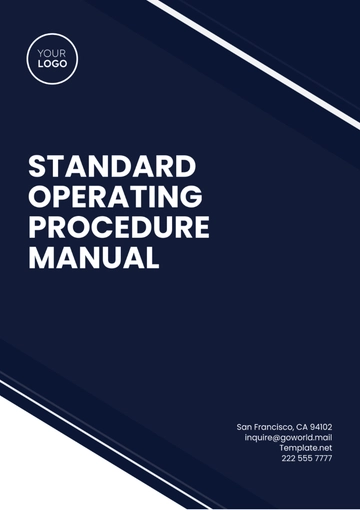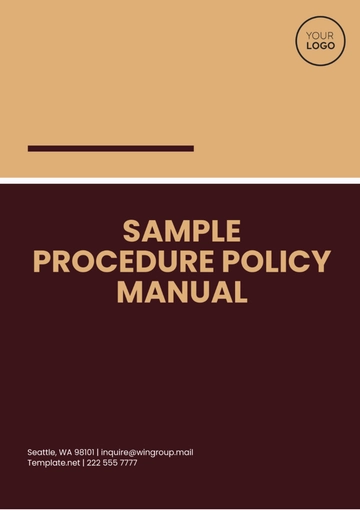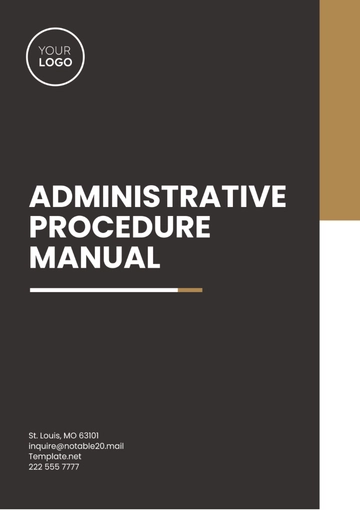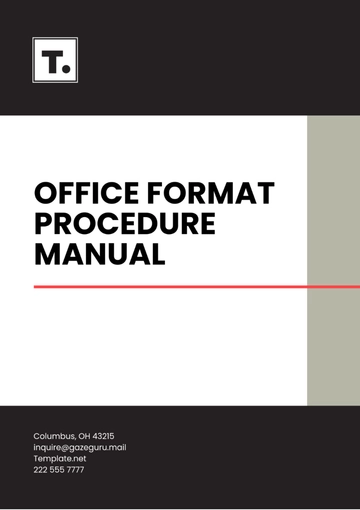Free Agriculture Safety Policy & Procedure Manual

I. Introduction
A. Purpose of the Manual
The Agriculture Safety Policy & Procedure Manual is designed to ensure the safety and well-being of all employees, contractors, and visitors involved in agricultural operations at [Your Company Name]. It outlines the policies, procedures, and guidelines necessary to prevent accidents, injuries, and illnesses, fostering a culture of safety across all facets of our agricultural activities.
B. Scope and Applicability
This manual applies to all employees, contractors, and visitors engaged in agricultural operations under the purview of [Your Company Name]. It encompasses all facilities, fields, and agricultural activities, including but not limited to machinery operation, chemical handling, livestock management, and fieldwork.
C. Commitment to Safety
[Your Company Name] is committed to maintaining the highest standards of safety in agricultural operations. We prioritize the health and safety of our workforce and the communities in which we operate. This commitment is integral to our operational philosophy and is reflected in our daily practices and decision-making processes.
II. Safety Management System
A. Safety Policy Statement
At [Your Company Name], safety is our top priority. We are dedicated to providing a safe and healthy work environment for all employees. We commit to complying with all applicable safety laws and regulations, continuously improving our safety performance, and fostering a culture where safety is everyone's responsibility.
B. Organizational Responsibilities
Management Commitment
Senior management at [Your Company Name] provides leadership and resources to support our safety initiatives. They are accountable for establishing and maintaining effective safety policies and procedures.
Employee Responsibilities
All employees are responsible for following safety procedures, using PPE as required, and reporting hazards or unsafe conditions promptly.
C. Safety Committee or Representatives
[Your Company Name]'s Safety Committee, including management and employee representatives, regularly meets to address safety concerns, review incident reports, and recommend improvements to maintain high safety standards.
III. Legal and Regulatory Requirements
A. Compliance with Agricultural Safety Regulations
[Your Company Name] adheres to all relevant local, state, and federal regulations pertaining to agricultural safety. This includes but is not limited to regulations concerning machinery operation, chemical handling, and environmental protection.
B. Relevant Occupational Health and Safety Standards
We comply with Occupational Safety and Health Administration (OSHA) standards applicable to agricultural operations, ensuring that our practices meet or exceed minimum safety requirements for the protection of our employees.
C. Environmental Regulations Impacting Safety
[Your Company Name] considers environmental factors in our safety practices, aiming to minimize our environmental impact while ensuring the safety of our employees and surrounding communities. We implement practices that mitigate potential environmental hazards associated with agricultural operations.
IV. Risk Management
A. Hazard Identification and Risk Assessment
Regular Hazard Assessments
Hazard assessments are conducted annually and before starting new projects or tasks. These assessments involve walkthroughs of work areas, consultation with employees, and review of incident reports to identify potential hazards such as machinery pinch points, chemical storage areas, and livestock handling facilities.
Risk Evaluation
Risks are evaluated based on the likelihood and severity of potential harm. We prioritize risks using risk matrices to determine which hazards pose the greatest threats to employee safety and organizational operations.
B. Control Measures and Safe Work Practices
Engineering Controls
Engineering controls are implemented to minimize exposure to hazards. Examples include installing machine guards on equipment, using automated systems to reduce manual handling of heavy materials, and implementing ventilation systems in enclosed spaces where chemicals are used.
Administrative Controls
Administrative controls include establishing safe work procedures, job rotation to minimize repetitive motion injuries, and scheduling maintenance during off-peak hours to reduce exposure to hazards.
C. Emergency Response and Preparedness
Emergency Procedures
Specific emergency procedures are outlined for different types of emergencies, including fire, chemical spills, severe weather, and medical emergencies. These procedures include evacuation routes, assembly points, and instructions for using emergency equipment like fire extinguishers and first aid kits.
Emergency Contacts
Employees are provided with a list of emergency contacts, including local emergency services, management personnel, and designated safety team members who are available 24/7 to respond to emergencies.
V. Personal Protective Equipment (PPE)
A. PPE Selection Criteria
Hazard Assessment
PPE selection is based on a thorough assessment of workplace hazards. For example, employees handling pesticides are provided with chemical-resistant gloves, goggles, and respirators to protect against inhalation and skin contact.
Compatibility and Effectiveness
Selected PPE must be compatible with the hazards present and effective in reducing exposure. Regular reviews and updates to PPE selections ensure they meet industry standards and employee needs.
B. PPE Use, Maintenance, and Inspection
Proper Use
Employees receive training on the proper use, fit, and limitations of PPE specific to their job duties. Training includes techniques for donning and doffing PPE, ensuring a proper seal for respiratory protection, and inspecting equipment for defects before each use.
Maintenance and Inspection
PPE is inspected regularly to ensure it remains in good condition. Inspections include checking for wear and tear, cleanliness, and proper functioning of components such as filters and seals. Damaged or defective PPE is promptly replaced.
C. Training on PPE Usage
Initial Training
During orientation, new employees receive comprehensive training on the selection, use, and care of PPE. Training includes hands-on demonstrations, videos, and quizzes to ensure understanding of PPE requirements and procedures.
Ongoing Training
Regular refresher courses are conducted to reinforce proper PPE usage and update employees on changes in safety standards or equipment. Training sessions also cover advancements in PPE technology and recommendations for improved protection.
VI. Agricultural Operations Safety
A. Machinery and Equipment Safety
Equipment Maintenance
Machinery undergoes regular maintenance based on manufacturer recommendations and usage logs. Maintenance tasks include lubrication, alignment checks, and calibration of safety devices to ensure equipment operates safely and efficiently.
Operator Training
Only trained and authorized personnel operate machinery. Training programs include classroom instruction, practical demonstrations, and supervised hands-on experience to familiarize operators with safe operating procedures and emergency shutdown protocols.
B. Chemical Handling and Storage
Safe Handling Practices
Employees handling chemicals receive specialized training on safe handling practices, including proper mixing, application techniques, and the use of personal protective equipment (PPE). Material Safety Data Sheets (MSDS) are reviewed before handling chemicals to understand hazards and emergency procedures.
Storage Requirements
Chemicals are stored in designated areas equipped with secondary containment measures to prevent spills and leaks. Storage facilities are ventilated, well-lit, and secured to restrict access to authorized personnel only.
C. Livestock Handling and Working Safely with Animals
Animal Behavior Awareness
Employees are trained to recognize signs of stress, aggression, or discomfort in livestock and to respond accordingly to minimize risk. Handling techniques focus on maintaining a safe distance, using appropriate restraining equipment, and avoiding sudden movements that may startle animals.
Handling Procedures
Standard operating procedures (SOPs) outline safe handling practices for various livestock species. Procedures include proper penning and sorting techniques, loading and unloading animals from transportation vehicles, and administering veterinary treatments under controlled conditions.
VII. Training and Education
A. Safety Training Programs
Orientation Training
New employees undergo comprehensive safety orientation covering general safety rules, emergency procedures, and hazard recognition. Training is tailored to specific job roles and responsibilities to ensure employees understand their role in maintaining a safe work environment.
Job-Specific Training
Employees receive specialized training relevant to their job tasks, such as operating specific machinery, handling hazardous materials, or performing confined space entry. Training programs incorporate practical demonstrations, simulations, and competency assessments.
B. New Employee Orientation
Introduction to Safety Policies
During orientation, new employees receive an overview of [Your Company Name]'s safety policies, procedures, and expectations. Emphasis is placed on the importance of safety in daily operations and the role each employee plays in maintaining a safe workplace.
Workplace Safety Tour
A guided tour of the workplace introduces new employees to safety features, emergency exits, first aid stations, and locations of safety equipment such as fire extinguishers and eye wash stations.
C. Continuous Education and Skill Development
Ongoing Training
Regularly scheduled workshops, seminars, and refresher courses are conducted to reinforce safety knowledge and skills. Topics include new safety regulations, updated procedures, and advancements in safety technology.
Certification Programs
Employees are encouraged to participate in certification programs relevant to their job roles, such as CPR/First Aid certification, forklift operator certification, or hazardous materials handling certification, to enhance safety competencies and compliance.
VIII. Incident Reporting and Investigation
A. Reporting Procedures for Accidents and Near Misses
Incident Reporting Form
Employees are required to complete an incident report form immediately following any accident, injury, near miss, or unsafe condition. The form includes fields for documenting details of the incident, location, witnesses, and actions taken.
Immediate Notification
Management and safety personnel are notified immediately of serious incidents requiring immediate action. Employees are encouraged to report all incidents promptly to facilitate timely investigation and corrective actions.
B. Incident Investigation Protocols
Investigation Team
A dedicated investigation team, including safety specialists and relevant department representatives, is assigned to conduct thorough investigations of reported incidents. The team gathers evidence, interviews witnesses, and analyzes contributing factors to determine root causes.
Documentation
Findings from incident investigations are documented in a detailed report, including identified hazards, contributing factors, and recommendations for corrective actions. Reports are reviewed by management to implement necessary changes and prevent recurrence.
C. Corrective Actions and Preventive Measures
Corrective Action Plan
Based on investigation findings, a corrective action plan is developed to address root causes and prevent similar incidents from occurring in the future. Actions may include revising procedures, providing additional training, or modifying equipment or facilities.
Preventive Measures
Proactive measures are implemented to mitigate potential risks identified through incident investigations. These measures include updating safety protocols, enhancing employee training, and improving hazard controls to continuously improve safety performance.
IX. Health and Wellness Programs
A. Health Promotion Initiatives
Wellness Programs
[Your Company Name] promotes employee health through comprehensive wellness programs that include fitness challenges, nutritional counseling, and wellness workshops. These initiatives aim to improve employee well-being, reduce absenteeism, and foster a healthy work environment.
Ergonomic Assessments
Ergonomic assessments are conducted to identify and address ergonomic risk factors in the workplace. By optimizing workstation design and promoting ergonomic practices, [Your Company Name] aims to prevent musculoskeletal disorders and enhance employee comfort and productivity.
B. Mental Health Support Services
Counseling Services
Confidential counseling services are available to employees to address a range of mental health concerns, including stress, anxiety, and depression. By providing access to professional support, [Your Company Name] supports employees in maintaining mental well-being and resilience.
Stress Management
Stress management workshops and resources are offered to equip employees with techniques for managing work-related stressors effectively. These initiatives promote a positive work environment and support employees in achieving a healthy work-life balance.
C. Access to Healthcare and Wellness Resources
Healthcare Benefits
Employees have access to comprehensive healthcare benefits that include medical, dental, and vision coverage. These benefits help ensure that employees receive timely medical care and preventive services, promoting overall health and well-being.
Wellness Resources
[Your Company Name] provides access to wellness resources such as health fairs, educational materials, and onsite health screenings. By empowering employees with knowledge and resources, [Your Company Name] encourages proactive health management and preventive care practices.
X. Communication and Consultation
A. Internal Communication Channels
Safety Bulletin Boards
Safety bulletin boards are strategically placed throughout the workplace to display safety information, updates on safety initiatives, and reminders about upcoming safety meetings. These boards serve as a visual reminder of [Your Company Name]'s commitment to safety and encourage ongoing safety awareness among employees.
Open Door Policy
[Your Company Name] maintains an open door policy that encourages employees to communicate safety concerns, suggestions for improvement, and feedback to management. By fostering open communication, [Your Company Name] ensures that safety issues are addressed promptly and collaboratively.
B. Consultation with Employees and Stakeholders
Employee Feedback
Input from employees is actively sought during safety meetings, toolbox talks, and formal consultations to identify safety hazards, assess the effectiveness of safety programs, and gather suggestions for improvement. This collaborative approach empowers employees to take ownership of safety and contributes to a proactive safety culture.
Stakeholder Engagement
[Your Company Name] engages with stakeholders, including contractors, suppliers, and regulatory agencies, to promote a collaborative approach to safety management. By sharing best practices, addressing mutual safety concerns, and aligning on safety standards, [Your Company Name] enhances overall safety performance and fosters positive relationships within the agricultural community.
C. Safety Meetings and Toolbox Talks
Regular Safety Meetings
Scheduled safety meetings are conducted to discuss current safety issues, review incident trends, and provide updates on safety regulations and procedures. These meetings provide a platform for communication, training, and continuous improvement in safety performance.
Toolbox Talks
Informal toolbox talks are conducted regularly before shifts or during breaks to address specific safety topics relevant to daily tasks. These brief discussions reinforce safety protocols, raise awareness of potential hazards, and encourage employee participation in maintaining a safe work environment.
XI. Evaluation and Improvement
A. Performance Monitoring and Safety Audits
Safety Performance Metrics
[Your Company Name] monitors safety performance using key performance indicators (KPIs) such as incident rates, near misses, and compliance with safety procedures. Performance metrics are tracked to identify trends, assess the effectiveness of safety initiatives, and prioritize areas for improvement.
Safety Audits
Scheduled and unscheduled safety audits are conducted to evaluate compliance with safety policies, procedures, and regulatory requirements. Audits involve comprehensive inspections of equipment, facilities, and work practices to identify deficiencies and implement corrective actions.
B. Review of Safety Policies and Procedures
Policy Review Cycle
Safety policies and procedures undergo regular review to ensure alignment with regulatory changes, industry best practices, and organizational goals. Stakeholder input, including feedback from employees and management, informs updates to enhance clarity, effectiveness, and relevance.
Continuous Improvement Initiatives
Feedback from safety audits, incident investigations, and employee suggestions drives continuous improvement initiatives in safety practices and procedures. [Your Company Name] embraces innovation in safety technologies and practices to proactively address emerging risks and enhance overall safety performance.
C. Training and Education Effectiveness
Training Effectiveness
The effectiveness of safety training programs is evaluated through assessments, feedback from participants, and observations of safety practices in the workplace. Evaluation results are used to refine training content, methods, and delivery to ensure maximum impact on safety knowledge and behavior.
Education Initiatives
[Your Company Name] promotes ongoing education initiatives to keep employees informed about new safety regulations, advancements in safety equipment, and industry trends. By investing in employee education, [Your Company Name] empowers individuals at all levels to contribute to a safer work environment and achieve organizational safety goals.
- 100% Customizable, free editor
- Access 1 Million+ Templates, photo’s & graphics
- Download or share as a template
- Click and replace photos, graphics, text, backgrounds
- Resize, crop, AI write & more
- Access advanced editor
Manage agricultural safety with ease using the Agriculture Safety Policy & Procedure Manual Template from Template.net. This editable and customizable template includes comprehensive guidelines for hazard assessment, PPE selection, and incident reporting. Enhance safety protocols effortlessly with the AI Editor Tool, ensuring compliance and fostering a secure work environment for all agricultural operations.





























